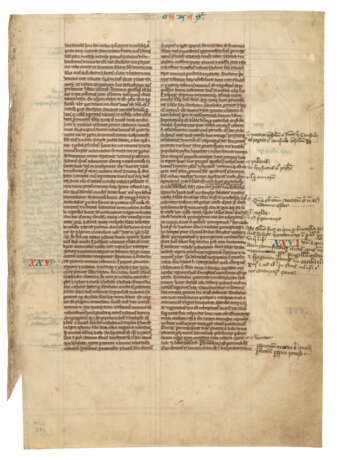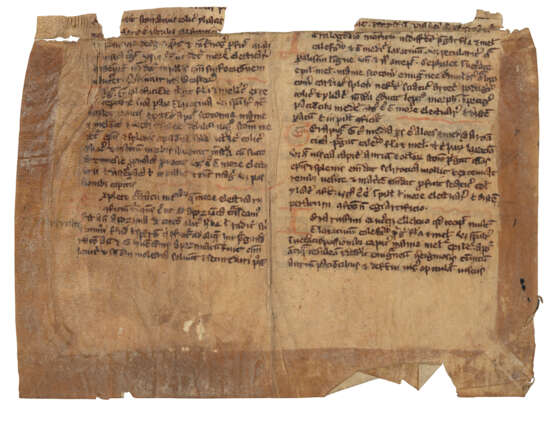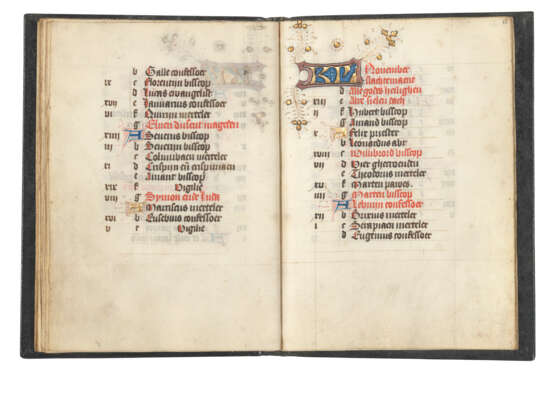ID 869565
Lot 158 | A Study Group
Estimate value
£ 4 000 – 6 000
A study group of leaves and fragments, in Latin, Dutch, and Middle English, manuscripts on vellum [13th to 15th centuries]
A selection of manuscripts from Western Europe, reflecting the range of Medieval interests across a Flemish chronicle, a medical guide, and an illuminated Calendar, with two leaves from Otto Ege's 'Cambridge Bible'.
Comprising:
(i) Two leaves of Ege’s ‘Cambridge Bible’, with some glosses containing Middle English [England, 13th century, c.1220s].
c.277 × 203mm. 2 columns of 60 lines, ruled in plummet, and written in an early gothic bookhand; foliated in modern pencil as f.8 and f.72, with text of the former comprising Genesis 24:47–27:36, and the latter comprising I Kings 5–9, with quire signature ‘VI’. Latin glosses in margin of Genesis in a later cursive hand, with a second even later cursive hand on the verso, glossing the manuscript's incorrect reading at l.55, 'irriguit' (for irrugiit) as ‘swouedde’, the perfect of Middle English swouen, ‘to roar, to sigh loudly’ (foliated in pencil as f.8 and f.72, upper and outer margins slightly trimmed).
Provenance: (1) John Charnoke [16th century]; (2) a present from Dr Heate to F.N.; (3) Otto F. Ege, who claimed that the book had belonged to Thomas Lever, master of St. John's College Cambridge in the 16th century (S. Gwara, Otto Ege’s Manuscripts, 2013, HL6), probably part of the 123-leaf cache sold by his heirs at Sotheby's, 26 November 1985, lot 49, bought by Maggs; (4) Colker MS 372; acquired in 1986 from Maggs.
(ii) Two fragments of a leaf from a medical text [England, 13th century].
c.110 × 150mm (both). Each half of the leaf with 2 columns of 21-28 lines, in an anglicana cursive script in black and red ink (vellum cockled with small holes, on one side remains of adhesive and vellum dirtied from use in a binding).
Provenance: Colker MS 472; acquired in 1996 from Unsworths, London.
(iii) A fragment from Eberhardus Bethuniensis, Graecismus [England, 13/14th century].
c.130 × 60mm. A strip from a leaf, preserving part of 11 lines of verse in a gothic bookhand (some pigment faded, remains of adhesive on one side).
Provenance: (1) Stephan Beissel (1841-1915); (2) Colker MS 297; acquired in 1980 from B.M. Rosenthal.
(iv) Two fragments of a leaf from Sigebertus Gemblacensis, Chronicon [Flanders, 14th century].
c.285 × 95mm (both). Each fragment preserving a column of 52 lines in a gothic bookhand, with text reporting on A.D. 900-912 (margins cropped, remains of adhesive, pigment faded on one side).
Provenance: (1) James Stevens Cox (1910-1997); (2) Colker MS 518, probably acquired from Maggs.
(v) A Grant of the right to own a portable altar, La Sposaas (diocese of Cordova), 1484.
c.227 × 305mm. Ruled in plummet for 22 lines with pricking on both edges, written in a humanist cursive script in light brown ink, endorsed in a contemporary hand.
Provenance: Colker MS 48; acquired in 1963 from Antonio de Guzman, Madrid.
(vi) A Calendar, in Dutch [15th century].
c.148 × 100mm. i + 13 + i leaves, pricking on fore-edge, ruled in plummet for 19 lines, with 37 illuminated initials, initials 'KL' on grounds of purple and blue with foliate ornament, written in a gothic bookhand in black and red ink; folios 1-12 each represent a chronological month, with the final leaf ruled, but without text (modern binding, and foliation in pencil, very small holes in the vellum of ff. 1-4).
Provenance: Colker MS O6; acquired in 1965 from the Folio Society.
| Auction house category: | Medieval & renaissance manuscripts |
|---|
| Auction house category: | Medieval & renaissance manuscripts |
|---|
| Address of auction |
CHRISTIE'S 8 King Street, St. James's SW1Y 6QT London United Kingdom | |
|---|---|---|
| Preview |
| |
| Phone | +44 (0)20 7839 9060 | |
| Buyer Premium | see on Website | |
| Conditions of purchase | Conditions of purchase |




















